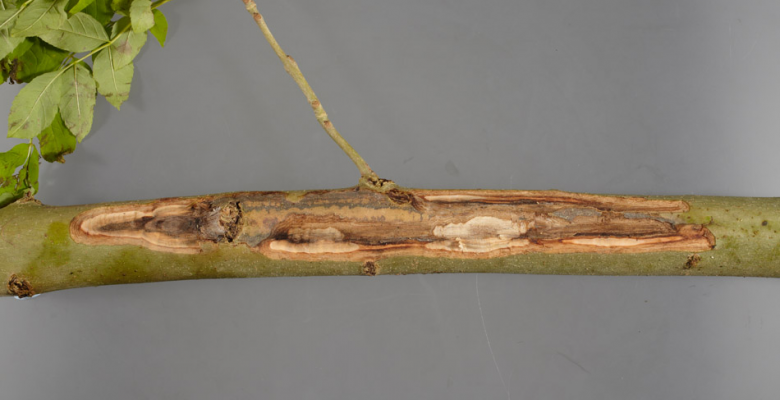Introduction
Ash dieback is one of the many fungal diseases prevalent in the UK. Its commonly used name is “Chalara” dieback of Ash (Hymenoscyphus fraxineus), which differentiates it from other dieback on ash trees that are completely unrelated. Chalara affects several species of ash, but not all. The bad news is that the most common species in Britain are the most susceptible, as are a few ornamental species.
When the existence of ash dieback first became known in 2012, it was mainly in the east of England and the ash population was expected to be wiped out. As it is one of the UK’s most common and useful trees, the prospect for the landscape was very bleak indeed.
My experience in the north east of England suggested we might possibly escape the worst of the disease here. I even began to wonder if the predictions were too pessimistic, as I just wasn’t seeing any obviously affected trees. Other arborists and tree officers in the region confirmed my observations; plenty of other equally damaging diseases to other tree species were seen though! Perhaps we were too pre-occupied with the Phytophthoras that were affecting so many of our trees. However, the situation has progressively changed for the worse with many cases identified locally – my own garden included – and nationally. Today, there is almost no region that is free of ash dieback.
Climate change, unusual weather patterns and lax import controls or biosecurity could be the causes of this disease.
How do we identify ash dieback?
With some difficulty it has to be said! Ash trees are always one of the last to come into leaf and people can easily be alarmed by the state of their ash tree in the spring. Chalara ash dieback can look very similar to other forms of dieback: if it looks like the leaves are not growing on parts of the crown then it could be Chalara. If you can actually see the stem or affected branches then you may see wilting leaves and petioles, or “lens shaped” lesions, as per the photograph above. Ash trees are also affected by other fungal diseases that are even harder to identify and of course many produce seed “keys” that can look like dying leaves from a distance. It’s often better to wait until the summer to identify it in larger specimens.
What is the impact of ash dieback?
Ash dieback can kill major branches which can then pose a risk to people and property. Often the disease weakens the tree which allows another disease to take hold, thus adding to the tree’s problems. In some instances, the whole tree can fail and it may be necessary to remove it completely before it gets to that point if there’s a safety risk.
How do we deal with ash dieback?
There are no effective strategies for managing the disease and those countries that have tried to do so have failed. One quite recent change to the advice is to monitor affected trees (especially the smaller trees) that aren’t an immediate danger. Those that don’t pose a risk may be better left to grow, as some specimens can and do recover and we need to encourage a more genetically diverse population with resistance to the disease. If an area of trees is so badly affected that the group has to be removed, it is best to leave the cleared land fallow for a few years to allow the spores to dissipate, but as it is largely a wind-borne disease, there are no truly effective protection measures.
Biosecurity is a whole other topic but it particularly applies here and the usual measures are recommended: it is vital that there are no imports from non-EU or regulated sources, not just because of the Chalara risk, but because there are other potentially more destructive pests and diseases that could be introduced. Also, some of the wind-borne ones are geographically very close now and there’s nothing we can do about that means of spreading. Those working with or near to known infected timber should keep boots, clothing and tools as sterile as is reasonably practical but, even then, there’s no guarantee that it won’t spread.
If you see a tree that you suspect is diseased, you can check its details against the Forest Research database, but it’s fair to say that it is everywhere and, as it can spread over tens of miles and is endemic but not notifiable, this is more for information and recording. It is also worth checking the Forestry Commission’s page on ash dieback which has the latest findings and recommendations. These are constantly being revising as we discover more about the progress of ash dieback: https://www.forestresearch.gov.uk/tools-and-resources/fthr/pest-and-disease-resources/ash-dieback-hymenoscyphus-fraxineus/.
If it isn’t obvious what actions you should take, it is best to get expert advice and EcoNorth can provide you with this service. For more information, please contact us at https://www.econorth.co.uk/contact/.
Written by David Beaver, Senior Arboriculturist Consultant, EcoNorth

